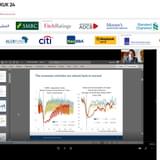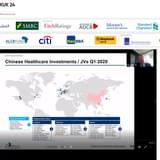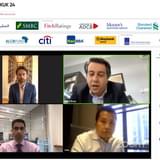The country’s decision in early November last year to remove Rs500 and Rs1,000 notes, which accounted for upwards of 82% of the bank notes in circulation, caused significant disruption in the weeks that followed – leading to day-long long queues at retail banks and a massive spike in bank deposits.
The move rippled through the country’s equities markets. The S&P BSE SENSEX and NIFTY 50 tumbled to record lows, with each losing close to 7% of their value in the two weeks following the government’s move.
But the demonetization also prompted an impressive rally in the country’s bond markets – which, as you likely recall, came at a time when uncertainty over US interest rate rises coupled with Donald Trump’s election victory prompted a reversal of emerging market capital flows. Trump vs. Modi, bond market analysts quipped at the time. Yields on Indian generic 10-year bonds fell 6.789% to 6.187% the day immediately following the move, the day after the US election – a result that caused broad EM credit indexes to spike by nearly 50bp.
Analysts know what prompted the rally, but are split on its sustainability. The rally, which is starting to show signs of reversal, was stoked largely by banks that used their massive stock of new deposits to buy government bonds. The immediate beneficiary was clearly the bond market. Front end spreads collapsed, average spreads narrowed.
However, a large chunk of those deposits is simply not long-term in nature, and once they erode, there are concerns the country’s financial institutions will likely seek to slowly unwind those trades, sending yields higher – and exacerbating a broader sell-off in the Indian bond market seen over the past four months. Since October last year, foreign investors and domestic mutual funds pulled nearly US$7bn from the country’s bond markets.
Bulls Versus Bears: Regulations Tilt to Favour the Former
“The rally is starting to unwind, and it isn’t sustainable,” said Arvind Chari, Co-Head of Fixed Income & Alternatives at Quantum Advisors. “Inflationary pressures excluding oil will remain fairly benign, the government is not expecting to increase its net borrowings much over last year, and the Reserve Bank of India is likely to hold rates steady despite inflation being below the long-term average because the US Federal Reserve looks likely to lift rates throughout the year.”
It is easy to see how some investors and asset managers are less than sanguine about the market’s prospects. In August 2013, average government bond yields ranged in the 9% region, but have since fallen by over 250bp. The RBI has also trimmed interest rates by 175bp since 2014, from 8% down to 6.25%.
“I think we’ve seen the best in terms of a large rally that can drive capital gains,” Chari explained.
Others are more bullish on the market’s prospects. Jayden Shah, Head of Debt Capital Markets at IDFC Bank said he expects increased supply from a number of sectors – finance and real estate predominately – due to a number of regulatory shifts.
In February, the RBI loosened banks’ restrictions around how they settle coupons on Basel III-compliant Additional Tier 1 capital instruments, allowing them to dip into their statutory reserves – instead of just general reserves – to make interest payments to investors. The move was largely designed to help ease a build-up of bad loans in the Indian banking sector, which are concentrated in just over a dozen state-owned banks.
Until now, the RBI only allowed banks to dip into distributable reserves or credit balances in their profit and loss accounts if the current year’s profits were insufficient to service. Indian banks put 25% of their profits per year into statutory reserves, according to CreditSights Research.
Analysts at CRISIL Ratings estimates the reserves available to service AT1 coupons under the new RBI guidelines will roughly double, relieving a great deal of pressure for some of the country’s largest lenders – some of which struggled to make coupon payments on their AT1 instruments last quarter.
“Significant easing of banks’ ability to pay their coupons means that we could see fresh supply of AT1 issuances in the primaries, particularly with many of the country’s lenders looking to boost their capital bases in anticipation of Basel III requirements,” Shah explained.
The wider bond market is also likely to benefit from additional rules introduced by the RBI in October. The Large Exposures Framework (LEF), which aims to halve bank exposures to single borrowers (including other banks) or a “closely related” group of borrowers and comes into effect in the spring of 2019, is likely to prompt a broad increase in supply across a range of sectors.
“The significance of the move is hard to overstate – especially when bonds are aggressively outpricing bank lending, a trend that could continue if non-performing loans remain high.”
Other sectors are likely to benefit from new measures introduced in the recent budget. The Modi government’s affordable housing initiative, ‘Housing for All by 2022,’ aims to see up to 20 million new units built over the next five years. An ambitious plan with aggressive targets, it has already attracted fresh investment from global funds (Qatar Holding recently pledged US$250mn for the plan) and will likely prompt fresh supply from construction companies and real estate developers.
Secondary Markets Will Continue to Lag
While supply volumes in the primaries continues to set records, observers still contend that the tallest hurdle holding the market back is the lack of a viable secondary market for corporate bonds. Primary market corporate bond supply over the past 10 months has exceeded over US$72bn, but the vast majority of that – about 98% according to figures from the Securities and Exchange Board of India (SEBI) – is placed privately, and trading is very thin. An average day will see about US$450mn worth of bonds traded in the corporate market, dwarfed by flows in the government bond segment, which are closer to US$13bn.
“The absence of a well-developed corporate bond repo market and secondary market infrastructure such as credit default swaps, interest rate futures, lack of participation on the dedicated debt segment of the exchanges etc. can be touted as some of the reasons due to the absence of liquidity in the secondary market,” the securities regulator said in a report published in February 2017.
SEBI and the government are trying to address this in a few ways.
One is to allow corporate issuers to consolidate their paper and reissue the same notes. Indian corporates – particularly frequent issuers – will regularly print different bonds with the same maturity date, causing unnecessary fragmentation in the market and headaches for investors. SEBI’s recently proposed changes include a mechanism that allows issuers to swap existing securities for new ones, allowing them to group their securities together, and subsequently re-tap the same notes.
The government is also taking steps to incentivise foreign investors into holding rupee-denominated bonds issued offshore. It recently announced it would reduce taxes on the transfer of so-called Masala bonds to 5% until 2020.
Nevertheless, some questions whether the moves are enough to stimulate this part of the market.
“Ultimately, the biggest bottleneck in the secondaries is the lack of market makers. Regulators are taking all the right steps, but until the market steps up and provides more liquidity, things are unlikely to change,” said one DCM banker at Citi in India. “CDSs are there. Corporate repos exist. But corporate bonds are still largely traded over the phone – that is just not a scalable model.”
“Few question the promise and continued growth in primary issuances this year – and because the rupee is largely sentiment driven, it has been a consistent outperformer, which bolsters that case further. But will the secondary market develop? Probably not,” she added.









